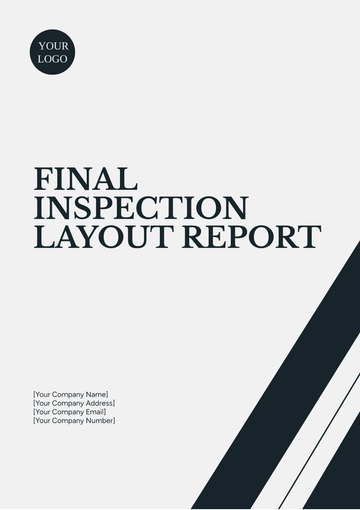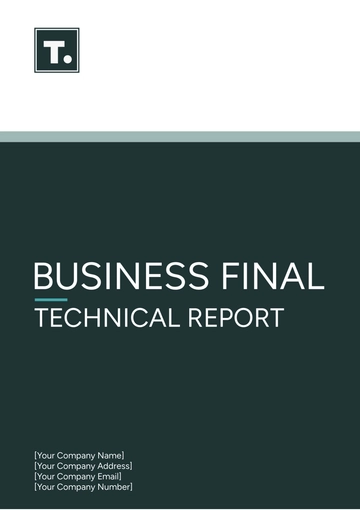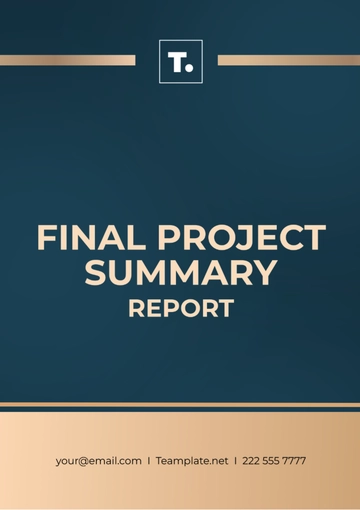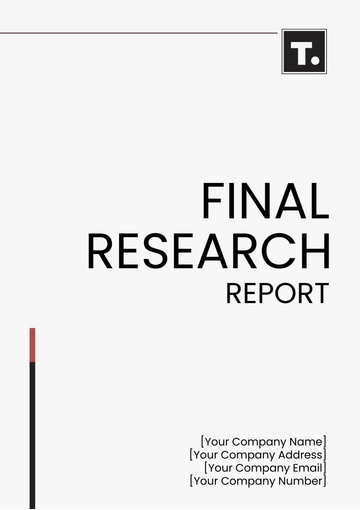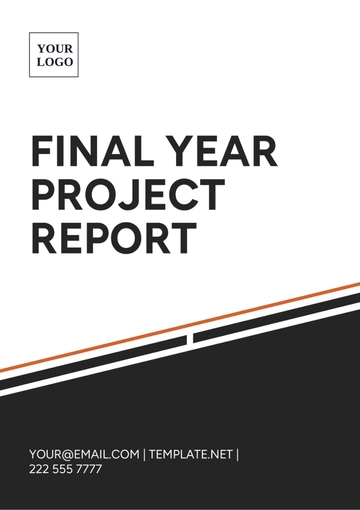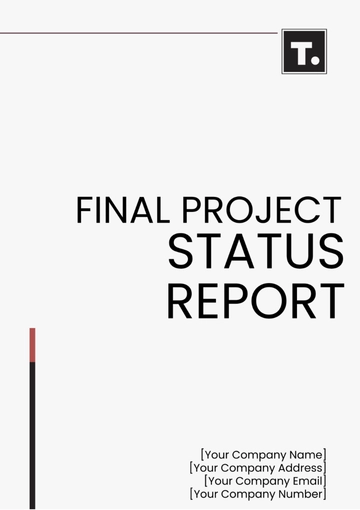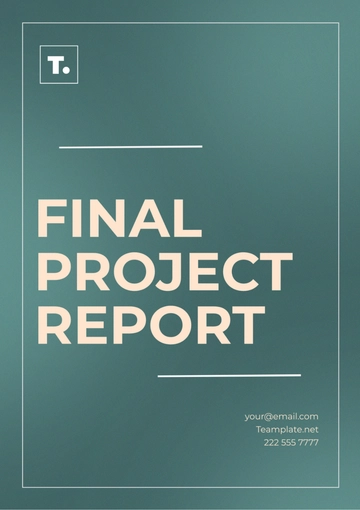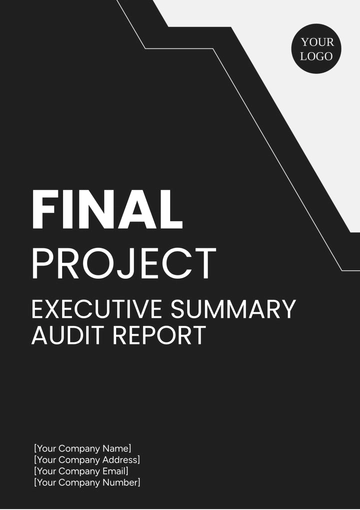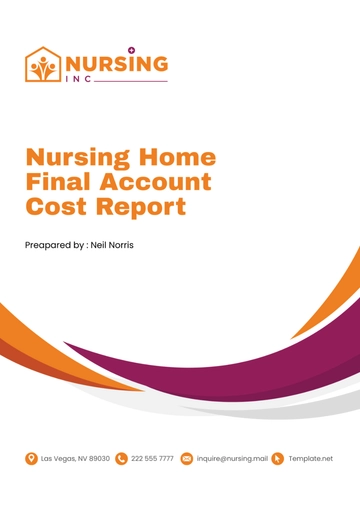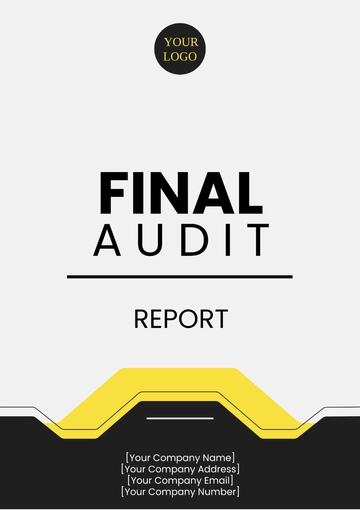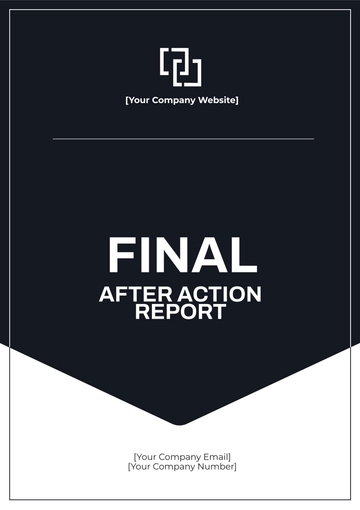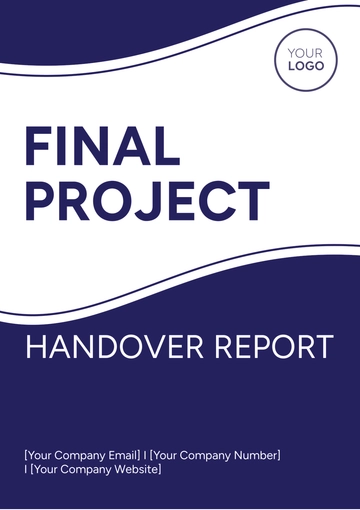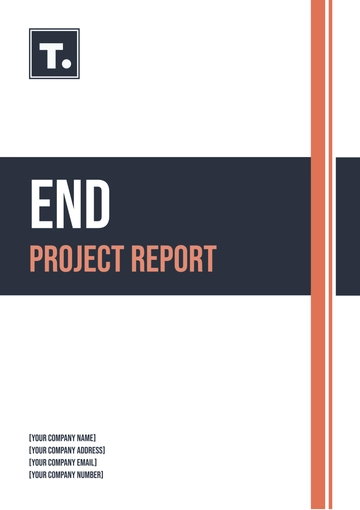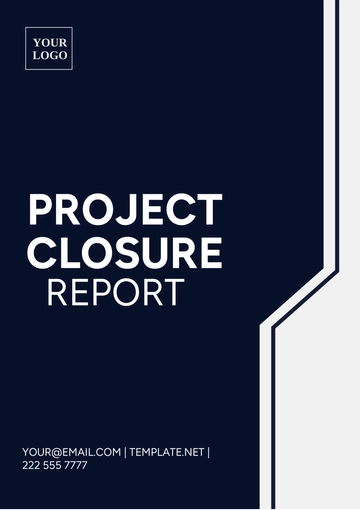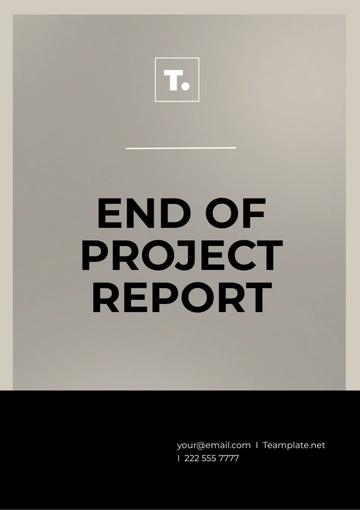Free End Of Project Report

Prepared by: [YOUR NAME]
Company: [YOUR COMPANY NAME]
Date : [CURRENT DATE]
I. Introduction
In today's dynamic business landscape, it's crucial for organizations to successfully conclude projects and communicate outcomes effectively. This report serves as the End Of Project Report for [PROJECT NAME], aiming to provide stakeholders, clients, and relevant parties with a detailed analysis of the project's achievements, challenges, and recommendations for future endeavors.
Purpose
The purpose of this report is to:
Assess the overall status and performance of the [PROJECT NAME].
Identify key achievements, challenges, and lessons learned throughout the project lifecycle.
Present actionable recommendations for improvement and future project management strategies.
Scope
This report will focus on the [PROJECT NAME] within the context of [YOUR COMPANY NAME]'s [YOUR DEPARTMENT].
It will cover:
Project overview and objectives.
Key achievements and milestones.
Challenges faced and lessons learned.
Recommendations for future projects.
II. Methodology
To gather relevant data and insights, a combination of qualitative and quantitative research methods were employed. This included:
Data Collection:
Surveys were conducted among stakeholders to gather opinions and feedback on project performance. Interviews were conducted with key project team members to gain deeper insights. Quantitative data from project management tools and databases were analyzed to identify trends and patterns.
III. Project Overview
The [PROJECT NAME] was initiated on [START DATE] with the primary objective of [OBJECTIVE OF THE PROJECT]. Throughout the project lifecycle, various milestones were achieved, including [LIST OF MILESTONES ACHIEVED]. The project team, consisting of members from [YOUR DEPARTMENT], worked diligently to ensure the successful execution of the project.
IV. Key Achievements
During the course of the project, several significant accomplishments were made, contributing to its overall success:
Successfully completed [TASK 1] within the allocated timeframe, resulting in [OUTCOME].
Implemented [STRATEGY/TECHNOLOGY/METHODOLOGY], leading to [POSITIVE IMPACT].
Resolved [NUMBER] of critical issues, ensuring uninterrupted progress of the project.
Achieved [SPECIFIC GOAL/METRIC], exceeding initial projections by [PERCENTAGE].
V. Challenges Faced
Despite the achievements, the project encountered several challenges that required prompt resolution. These challenges included:
Resource Constraints: Limited availability of [RESOURCE], necessitating optimization of existing resources.
Scope Creep: Additional requirements emerged during the project execution phase, leading to adjustments in the project scope and timeline.
Communication Issues: Instances of miscommunication between team members and stakeholders, resulting in delays and misunderstandings.
External Factors: Unforeseen external factors such as [FACTOR], which impacted project timelines and deliverables.
VI. Findings
The analysis of project data and stakeholder feedback revealed several key findings:
Current Status: The analysis reveals that [CURRENT STATUS OF PROJECT] is [DESCRIPTION OF CURRENT STATUS].
Strengths: There are areas of strength, such as [STRENGTH 1] and [STRENGTH 2].
Weaknesses: However, there are also notable weaknesses, including [WEAKNESS 1] and [WEAKNESS 2].
VII. Lessons Learned
The project provided valuable insights and lessons that can be applied to future endeavors:
Effective Communication: Emphasize clear and consistent communication channels to ensure alignment among team members and stakeholders.
Resource Management: Implement robust resource allocation strategies to mitigate the impact of resource constraints on project timelines.
Risk Management: Proactively identify and address potential risks to minimize their impact on project outcomes.
Stakeholder Engagement: Foster stronger stakeholder engagement throughout the project lifecycle to enhance transparency and collaboration.
VIII. Recommendations
Based on the project experience, the following recommendations are proposed for consideration in future projects:
Continuous Improvement: Establish a culture of continuous improvement to streamline processes and optimize project outcomes.
Risk Mitigation Strategies: Develop comprehensive risk mitigation strategies to proactively address potential challenges.
Enhanced Stakeholder Engagement: Strengthen stakeholder engagement initiatives to foster a more collaborative project environment.
Investment in Training and Development: Prioritize training and development initiatives to equip team members with the necessary skills and knowledge for project success.
IX. Conclusion
In conclusion, the [PROJECT NAME] has been successfully completed, thanks to the dedication and hard work of the project team. Despite encountering challenges along the way, the project achieved its objectives and delivered value to stakeholders. Moving forward, the lessons learned and recommendations provided will serve as valuable guidance for future projects. We extend our gratitude to all stakeholders for their support throughout the project lifecycle.
For any further inquiries or clarifications, please contact [YOUR NAME] at [YOUR EMAIL ADDRESS].
- 100% Customizable, free editor
- Access 1 Million+ Templates, photo’s & graphics
- Download or share as a template
- Click and replace photos, graphics, text, backgrounds
- Resize, crop, AI write & more
- Access advanced editor
Discover efficiency and clarity with Template.net's End Of Project Report Template. This meticulously crafted document is fully editable and customizable, ensuring seamless adaptation to your unique project needs. Harness the power of our AI Editor Tool to effortlessly tailor every detail to perfection. Streamline your project reporting process today!
You may also like
- Sales Report
- Daily Report
- Project Report
- Business Report
- Weekly Report
- Incident Report
- Annual Report
- Report Layout
- Report Design
- Progress Report
- Marketing Report
- Company Report
- Monthly Report
- Audit Report
- Status Report
- School Report
- Reports Hr
- Management Report
- Project Status Report
- Handover Report
- Health And Safety Report
- Restaurant Report
- Construction Report
- Research Report
- Evaluation Report
- Investigation Report
- Employee Report
- Advertising Report
- Weekly Status Report
- Project Management Report
- Finance Report
- Service Report
- Technical Report
- Meeting Report
- Quarterly Report
- Inspection Report
- Medical Report
- Test Report
- Summary Report
- Inventory Report
- Valuation Report
- Operations Report
- Payroll Report
- Training Report
- Job Report
- Case Report
- Performance Report
- Board Report
- Internal Audit Report
- Student Report
- Monthly Management Report
- Small Business Report
- Accident Report
- Call Center Report
- Activity Report
- IT and Software Report
- Internship Report
- Visit Report
- Product Report
- Book Report
- Property Report
- Recruitment Report
- University Report
- Event Report
- SEO Report
- Conference Report
- Narrative Report
- Nursing Home Report
- Preschool Report
- Call Report
- Customer Report
- Employee Incident Report
- Accomplishment Report
- Social Media Report
- Work From Home Report
- Security Report
- Damage Report
- Quality Report
- Internal Report
- Nurse Report
- Real Estate Report
- Hotel Report
- Equipment Report
- Credit Report
- Field Report
- Non Profit Report
- Maintenance Report
- News Report
- Survey Report
- Executive Report
- Law Firm Report
- Advertising Agency Report
- Interior Design Report
- Travel Agency Report
- Stock Report
- Salon Report
- Bug Report
- Workplace Report
- Action Report
- Investor Report
- Cleaning Services Report
- Consulting Report
- Freelancer Report
- Site Visit Report
- Trip Report
- Classroom Observation Report
- Vehicle Report
- Final Report
- Software Report
